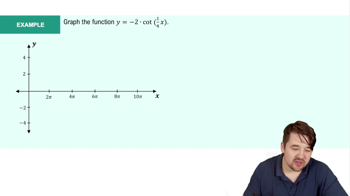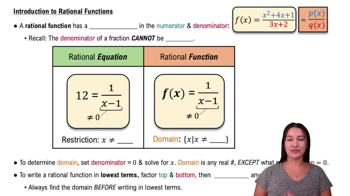Table of contents
- 0. Functions7h 52m
- Introduction to Functions16m
- Piecewise Functions10m
- Properties of Functions9m
- Common Functions1h 8m
- Transformations5m
- Combining Functions27m
- Exponent rules32m
- Exponential Functions28m
- Logarithmic Functions24m
- Properties of Logarithms34m
- Exponential & Logarithmic Equations35m
- Introduction to Trigonometric Functions38m
- Graphs of Trigonometric Functions44m
- Trigonometric Identities47m
- Inverse Trigonometric Functions48m
- 1. Limits and Continuity2h 2m
- 2. Intro to Derivatives1h 33m
- 3. Techniques of Differentiation3h 18m
- 4. Applications of Derivatives2h 38m
- 5. Graphical Applications of Derivatives6h 2m
- 6. Derivatives of Inverse, Exponential, & Logarithmic Functions2h 37m
- 7. Antiderivatives & Indefinite Integrals1h 26m
- 8. Definite Integrals4h 44m
- 9. Graphical Applications of Integrals2h 27m
- 10. Physics Applications of Integrals 2h 22m
1. Limits and Continuity
Finding Limits Algebraically
Problem 71b
Textbook Question
Find the vertical asymptotes. For each vertical asymptote x=a, analyze lim x→a- f(x) and lim x→a+ f(x).
f(x) = (2x3 + 10x2 + 12x) / (x3 + 2x2)
 Verified step by step guidance
Verified step by step guidance1
Step 1: Identify the points where the denominator is zero, as these are potential vertical asymptotes. Set the denominator equal to zero: \(x^3 + 2x^2 = 0\).
Step 2: Factor the equation from Step 1: \(x^2(x + 2) = 0\). Solve for \(x\) to find the potential vertical asymptotes.
Step 3: The solutions to \(x^2(x + 2) = 0\) are \(x = 0\) and \(x = -2\). These are the x-values where the function may have vertical asymptotes.
Step 4: Analyze the behavior of \(f(x)\) as \(x\) approaches each potential vertical asymptote from the left and right. For \(x = 0\), evaluate \(\lim_{x \to 0^-} f(x)\) and \(\lim_{x \to 0^+} f(x)\).
Step 5: Similarly, for \(x = -2\), evaluate \(\lim_{x \to -2^-} f(x)\) and \(\lim_{x \to -2^+} f(x)\) to determine the behavior of the function near this point.
 Verified video answer for a similar problem:
Verified video answer for a similar problem:This video solution was recommended by our tutors as helpful for the problem above
Video duration:
5mPlay a video:
Was this helpful?
Key Concepts
Here are the essential concepts you must grasp in order to answer the question correctly.
Vertical Asymptotes
Vertical asymptotes occur in a function when the function approaches infinity or negative infinity as the input approaches a certain value. This typically happens at points where the denominator of a rational function equals zero, provided the numerator does not also equal zero at those points. Identifying these points is crucial for understanding the behavior of the function near those values.
Recommended video:

Introduction to Cotangent Graph Example 1
Limits
Limits are fundamental in calculus, representing the value that a function approaches as the input approaches a certain point. In the context of vertical asymptotes, evaluating the left-hand limit (lim x→a<sup>-</sup> f(x)) and the right-hand limit (lim x→a<sup>+</sup> f(x)) helps determine the behavior of the function as it nears the asymptote. This analysis reveals whether the function tends toward positive or negative infinity.
Recommended video:

One-Sided Limits
Rational Functions
A rational function is a ratio of two polynomials, expressed as f(x) = P(x)/Q(x), where P and Q are polynomials. The behavior of rational functions, particularly their asymptotic behavior, is influenced by the degrees and leading coefficients of the polynomials in the numerator and denominator. Understanding the structure of rational functions is essential for analyzing their limits and identifying vertical asymptotes.
Recommended video:

Intro to Rational Functions

 5:21m
5:21mWatch next
Master Finding Limits by Direct Substitution with a bite sized video explanation from Callie
Start learningRelated Videos
Related Practice







